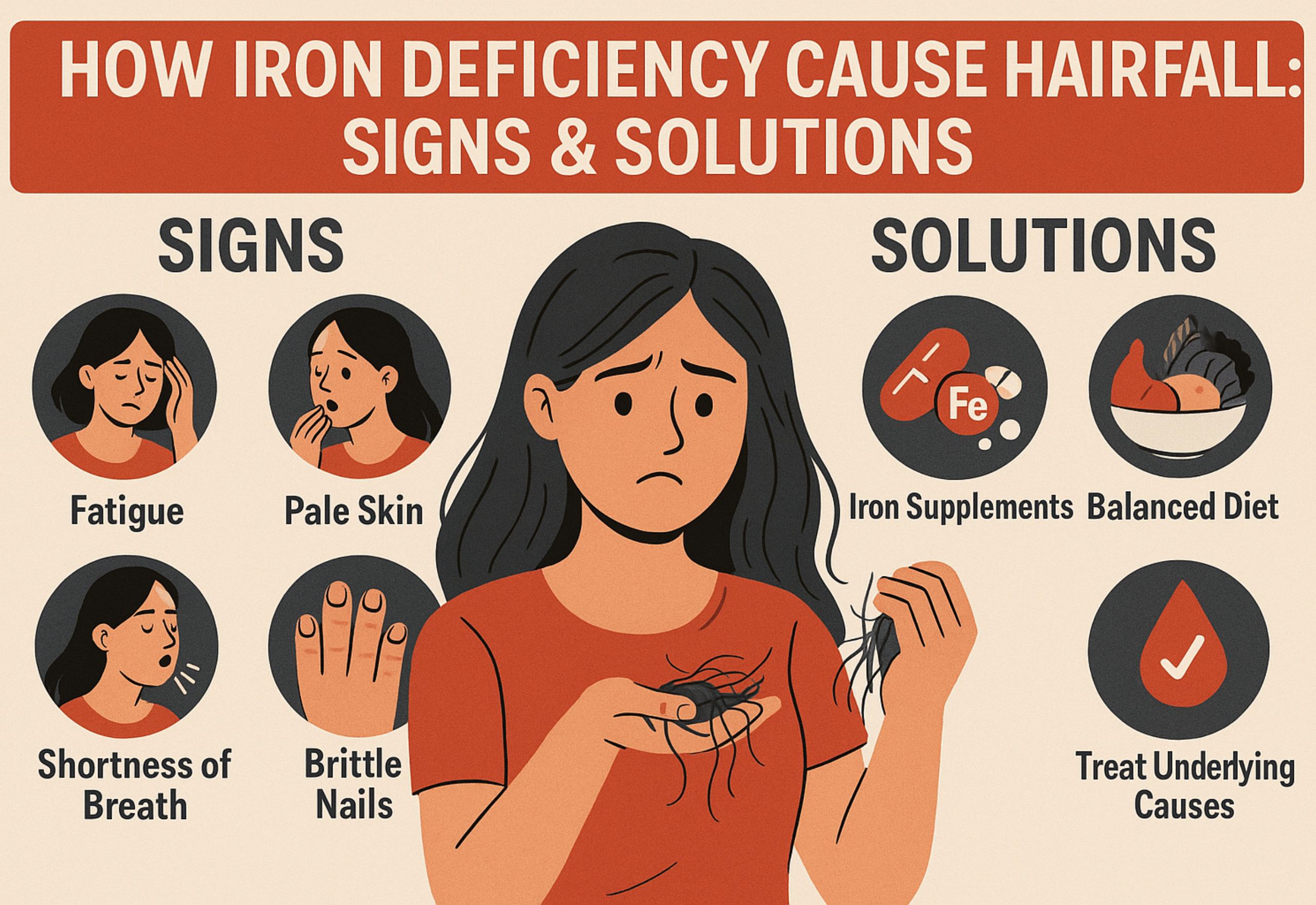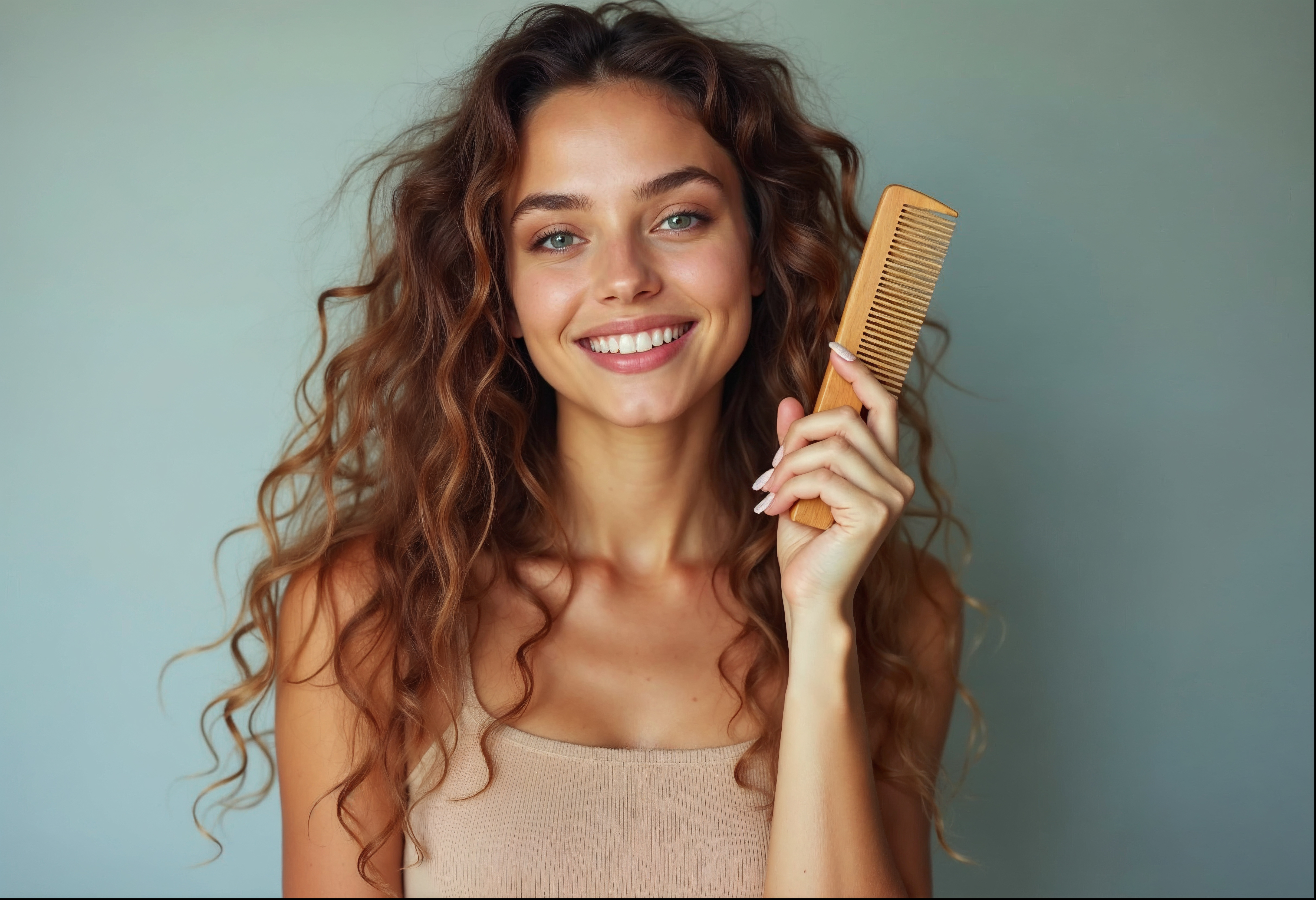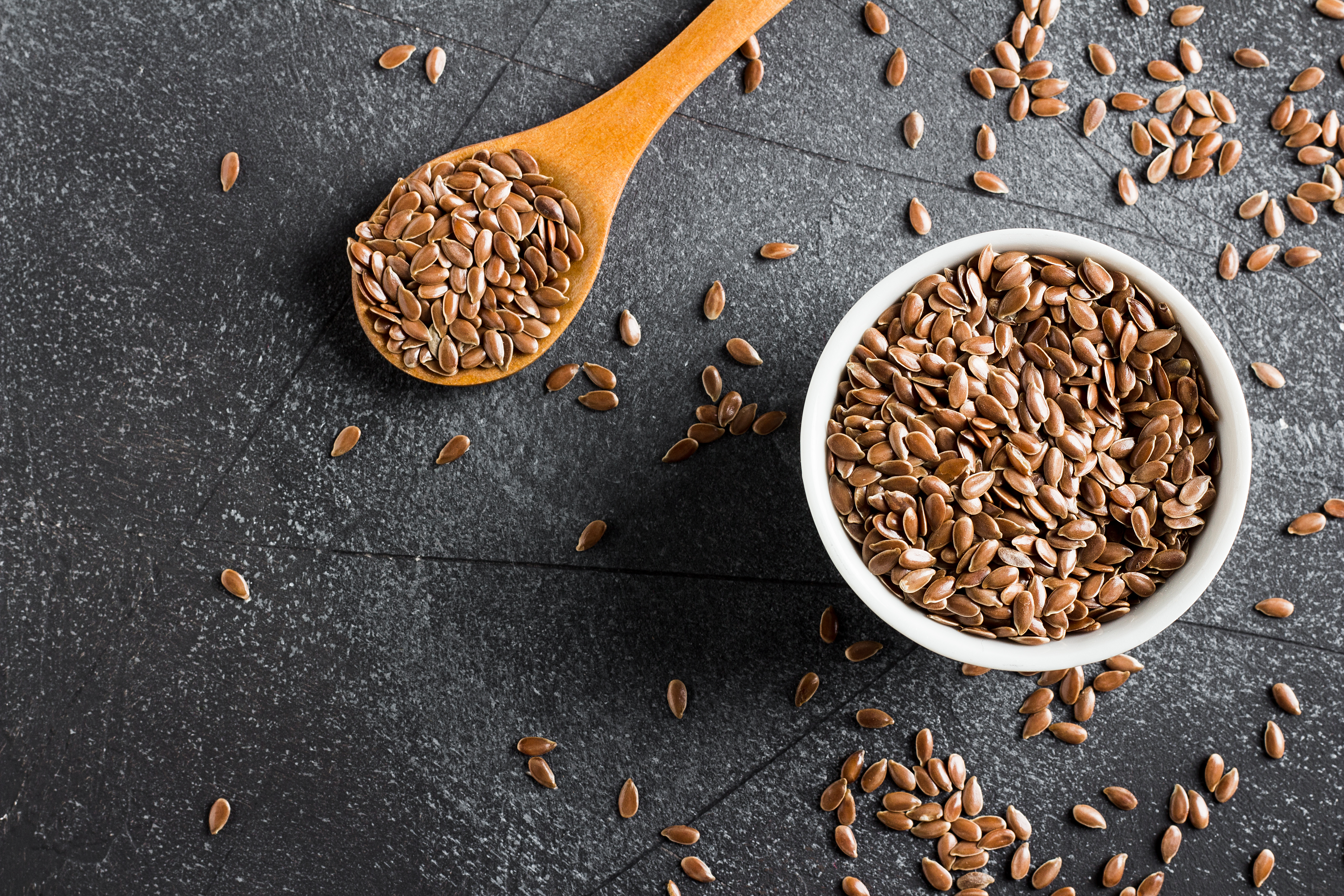Are you noticing more hair in the brush lately? For many people, this may not only be a cosmetic concern, but this could also be hair loss due to anemia. Iron plays an essential role in producing red blood cells, which supply oxygen to hair follicles and also neurons located in the scalp. When you deplete your body of iron, your body can no longer create hair at the most optimal level, causing thinning strands and slower hair growth.
The first step to realizing how iron deficiency causes hair fall shedding is to recognize the signs of iron deficiency hair loss. It’s important to recognize important signs of iron deficiency hair loss and natural methods to restore the health, strength and fullness of your hair.
Also Read: Best Vitamins and Minerals for Stronger, Thicker Hair
The Importance of Iron for Healthy Hair
Beyond the fundamental function of hair, iron supports healthy and active hair follicles. Iron supports hemoglobin production, which then supports oxygen to the hair follicle and scalp. Without iron, nourishment of the hair follicles is decreased, and the growth of hair is reduced. Over time, iron deficiency causes hair loss. Many of the strands fall out before full maturation, resulting in bald spots and thinning.
How healthy iron levels are valuable to your hair:
1: Encouraging Growth: Healthy iron helps the follicles access the oxygen that they need for constant and continuous growth.
2: Thickening the Strands: When roots are nourished, the hair produced is going to be thicker and easier to sustain.
3: Regulating the Growth Cycle: Iron helps to prevent follicles from entering a premature shedding cycle.
4: Promoting a Healthy Scalp: Ensuring proper oxygen supply to the scalp ensures a scalp environment that is conducive to growth.
Think of your hair as a plant; when you don’t provide constant nourishment, growth will be slow, and strands will become weaker and shed more frequently. Healthy iron levels are one of the most effective ways to keep your hair stronger, fuller, and healthier.
How Iron Deficiency Causes Hair Loss: Symptoms and Solutions
Iron is important in getting oxygen to hair follicles. Low levels of iron reduce the man nutrients that promote healthy strands and are also linked to hair loss due to anemia.
Here’s how hair health suffers at low iron levels:
1: Lack of oxygenation: Oxygen levels must be at appropriate levels for your follicles to create a healthy and strong strand of hair.
2: Weakening strand structure: Hair strands can lose their strength, and brittle strands can also break more easily.
3: Shortened growth cycle of hair: Hair may shed sooner than you would expect, ultimately making your hair look visibly thinner.
4: Delayed hair growth: The new hair takes a longer time to grow, making hair loss more noticeable.
These factors are typically referred to as hair loss due to anemia. Therefore, you must recognize the early signs of iron deficiency hair loss, so you can reverse it.
Also Read: How Onion Juice Helps Regrow Hair: Myth or Fact?
How to Determine If Hair Loss Might be Related to Iron Deficiency
If you notice unusual hair loss, the first thing to assess is your iron levels. A blood test is needed to confirm hair loss due to anemia or whether iron deficiency causes hair loss, so the treatment can be provided based on the result.
Blood tests you might want to use to determine your levels of iron deficiency are:
1: Ferritin: Low levels suggest depletion of stored iron.
2: Hemoglobin: Low levels suggest shedding due to anemia.
3: Transferrin Saturation: Used to assess how much iron is being delivered to the hair follicles.
Why interpretation by your doctor is important
Many factors might cause high or low levels of iron. Consider inflammation, chronic illness, or even very recent infections. Verifying your results with a healthcare provider allows you to ask additional questions and get the right iron supplement dosage. Additionally, you don’t want to risk iron overload, as it can be harmful.
Also Read: Platelet-Rich Plasma (PRP) Therapy for Hair Loss: Benefits & Side Effects
Natural Ways to Improve Iron and Encourage Hair Growth
One of the safest and most effective ways to treat low iron through the diet is to increase your intake of foods that contain iron. Providing your body with the needed nutrients will keep your follicles active and help avoid exacerbated iron-deficiency hair loss.
Iron-rich foods to eat include:
1: Animal sources (heme iron): Lean red meat, chicken, turkey, liver, and fish; this type of iron is easily absorbed.
2: Plant sources (non-heme iron): spinach, lentils, kidney beans, tofu, pumpkin seeds, and quinoa. For best absorption, add vitamin C.
Vitamin C sources:
1: Fresh fruits: oranges, strawberries, kiwi.
2: Vegetables: bell peppers, broccoli.
3: Squeeze lemon juice on some foods
Things to watch:
1: Limit excessive tea and coffee.
2: Limit high-calcium foods at meal times containing iron.
Any small change in diet can help restore iron levels, which will contribute to better scalp health, which, hopefully, will contribute to thicker hair over time.
When to Consider Supplements or Medical Treatment
Use medical treatment if diet alone cannot get you to the recommended levels of iron, especially if you have a significant deficiency and have possibly seen some signs of iron-deficiency hair loss. In these situations, a doctor may suggest iron supplements to increase your levels more effectively.
Common types of iron supplements.
1: Ferrous sulfate: the most common and cheapest option.
2: Ferrous gluconate: a safer option for people who are sensitive to iron.
3: Ferrous fumarate: another effective form of iron, slightly higher in iron content.
Also Read: Dermarolling for Hair Regrowth: Everything You Need to Know
Important points for you to remember
1: Supplements should only start once a blood test confirms low iron.
2: Without medical advice, excess iron can cause iron overload, which is not good for your health.
3: Your physician will give you a specific dosage and the time to take it based on your ferritin and hemoglobin.
If you have lost a lot of hair in advanced stages due to anemia, your doctor will have to rule out any other possible reasons for your deficiency, like heavy menstrual bleeding, gastrointestinal issues, chronic disease, etc.
Supporting Hair Regrowth While Correcting Iron Deficiency
Restoring adequate iron levels is important, but simultaneously supporting your hair recovery might be the most impactful step to improve how quickly and visibly you recover from iron deficiency. Since iron deficiency causes hair fall through the impairment of hair follicle growth, giving your beautiful hair a supportive and hair-healthy life will ensure that when your hair grows back, it is stronger than ever.
Gently supportive hair care ideas:
1: Choose a gentle, sulfate-free shampoo to avoid stripping natural oil and moisture from the strands.
2: Reduce styling, chemical treatments, or any other form of heat treatment while your hair is gaining back its strength.
3: Do not wear tight hairstyles that pull on the already fragile strands.
Things that support hair health alongside iron:
1: Protein: The building block of hair.
2: Zinc: Zinc is important for the repair of hair follicles.
3: Biotin: Biotin protects the hair as it creates keratin giving the hair strands strength.
4: Omega-3 fatty acids: Encourage hydration and nutrient transport by improving blood circulation to the scalp.
Tips for the scalp:
1: Regularly massage your scalp; this helps nutrients flow
2: Keep your scalp clean and free from build-up that can clog your hair follicles.
Incorporating these habits of looking after your hair and scalp, along with your plan to correct your iron levels, will create the best platform for your hair to bounce back and grow.
Monitoring Progress and Mistakes to Avoid
Recovering from hair loss due to anemia may take a while because your hair follicles have various growth cycles before you can see any changes. Your most important factor is consistency with your iron intake, nutrition, and hair care.
Here are some ideas for tracking your process:
1: Hair growth journal: document how much, the size of the shedding, the thickness of hair, and the texture differences.
2: Scalp Pictures: Take clear pictures every 4-6 weeks so you have a visual comparison.
3: Health checks: After 3-6 months have blood work done to retest your ferritin and hemoglobin levels and the extent of improvement.
Also Read: Scalp Detox: Does It Really Help With Hair Growth?
Mistakes to avoid include:
1: Taking an iron supplement without ensuring a deficiency.
2: Stopping treatment too early when the iron deficiency causes hair fall.
3: Focusing only on iron deficiency and not considering other possible causes of shedding (hormonal, thyroid).
Yes, it is important to note that even with hair fall from iron deficiency, regrowth is possible, but most issues surrounding imbalances can be noted after 3–6 months of consistent effort. Be patient and don’t stop your regimen too soon.
Conclusion
When you experience hair loss due to anemia or losing hair by iron deficiency, don’t hesitate. Identify the symptoms, identify the iron levels with testing, and stay on a consistent track with your plan to restore your levels. With consistency, improved nutrition, and scalp care, your hair follicles will produce beautiful, healthy hair. Start today. These small steps lead to fuller, shinier hair strands.
FAQs
1. Can iron deficiency still cause hair loss when my hemoglobin levels are normal?
Yes. Hemoglobin can be perfectly normal, but stored ferritin can be so low enough for it to influence hair growth.
2. Is hair loss from iron deficiency always reversible, no matter how old they are?
In most cases, yes. However, the speed at which recovery may be made can depend on age, general health, as well as the extent of the iron deficiency.
3. Can repeated blood donation experienced repeatedly have an effect on hair loss from iron deficiency?
Yes. Repeated blood donation decreases iron storage, which at times can lead to hair shedding when iron-rich foods and/or supplementation are not continued after the blood donation.
4. Is it true that women suffer from hair loss due to iron deficiency more than men?
Yes, many factors, including menstruation, pregnancy, and postpartum requirements for iron, determine demands on women, thus contributing to iron deficiency.
5. Does hair loss from low iron tend to be amplified because of stress?
Yes. Exposure to stress can be a trigger for telogen effluvium shedding, which may compound hair loss attributable to low iron levels.
6. Does exercise itself have an impact on iron levels and hair?
Whatever affects iron levels will also affect hair. Complete distance endurance exercise can utilize iron levels in sweat and the turnover of red blood cells, which will affect hair.
7. How soon after addressing iron deficiency will I notice hair regrowth?
Visible changes due to the hair growth cycle will usually take 3–6 months.
8. Are there any non-blood test ways to recognize a possible impact of iron deficiency on my hair?
Signs of low iron levels can include brittle nails, unexplained fatigue, pale skin, and slow wound healing; however, iron levels can only be accurately identified through a blood test.
9. Can low iron affect hair color or texture?
Yes. Deficient hair follicles may produce hair that is duller, coarser, or more brittle than what was typical before the deficiency.
10. Are there any hair care products that can help while recovering from iron deficiency?
Products themselves cannot fix the issue, but fortifying shampoos, scalp serums, and a gentler technique to detangle can keep things from breaking as you return to health.



